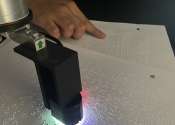Robot trained to read braille at twice the speed of humans
Researchers have developed a robotic sensor that incorporates artificial intelligence techniques to read braille at speeds roughly double that of most human readers.
Jan 29, 2024
0
38
Robotics

Researchers have developed a robotic sensor that incorporates artificial intelligence techniques to read braille at speeds roughly double that of most human readers.
Jan 29, 2024
0
38
Electronics & Semiconductors

Imagine an iPad or a Kindle for the blind, with inflatable Braille that changes shape under a user's touch. A Cornell-led collaboration has made a crucial component for such a technology: A haptic array of densely packed ...
Oct 5, 2021
0
491
Computer Sciences

In recent years, computer scientists have developed artificial intelligence-based techniques that can complete a wide variety of tasks. Some of these techniques are designed to artificially replicate the human senses, particularly ...
Engineering

Researchers at Bayreuth University have developed a digital-age speaker system that permits the blind to read Braille using ultrasound waves in mid-air.
Software

Google released a built-in virtual Braille keyboard for blind and visually impaired users last week. The new TalkBack keyboard was enabled Thursday on devices running Android 5.0 or later. Distribution will continue throughout ...
Hardware

A new standard for braille displays has come on the scene, and it is backed by the giants in tech.
Engineering

Braille displays for the blind are one way for the blind to access information. The National Braille Press said technology for Braille displays has been around for several decades, but since blindness is a low incidence disability ...
The Braille system is a method that is widely used by blind people to read and write, and was the first digital form of writing.
Braille was devised in 1825 by Louis Braille, a blind Frenchman. Each Braille character, or cell, is made up of six dot positions, arranged in a rectangle containing two columns of three dots each. A dot may be raised at any of the six positions to form sixty-four (26) possible subsets, including the arrangement in which no dots are raised. For reference purposes, a particular permutation may be described by naming the positions where dots are raised, the positions being universally numbered 1 to 3, from top to bottom, on the left, and 4 to 6, from top to bottom, on the right. For example, dots 1-3-4 (⠍) would describe a cell with three dots raised, at the top and bottom in the left column and on top of the right column, i.e., the letter m. The lines of horizontal Braille text are separated by a space, much like visible printed text, so that the dots of one line can be differentiated from the Braille text above and below. Punctuation is represented by its own unique set of characters.
This text uses material from Wikipedia, licensed under CC BY-SA